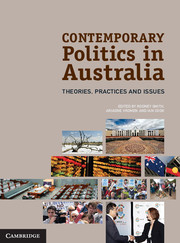Book contents
- Frontmatter
- Contents
- Tables and figures
- Contributors
- Acknowledgements
- Introduction
- I Contemporary Theories of Australian Politics
- Part II Politics in Everyday Australian Life
- Part III Elections
- Part IV Participation and Representation
- Part V Inside the Australian State
- Introduction to Part V
- 19 Parliament
- 20 Prime ministerial government in Australia
- 21 Politicisation and the executive
- 22 Delivering public policy
- 23 The courts
- 24 Federalism
- Part VI Contemporary Public Controversies
- Glossary
- References
- Index
- References
20 - Prime ministerial government in Australia
from Part V - Inside the Australian State
Published online by Cambridge University Press: 05 June 2012
- Frontmatter
- Contents
- Tables and figures
- Contributors
- Acknowledgements
- Introduction
- I Contemporary Theories of Australian Politics
- Part II Politics in Everyday Australian Life
- Part III Elections
- Part IV Participation and Representation
- Part V Inside the Australian State
- Introduction to Part V
- 19 Parliament
- 20 Prime ministerial government in Australia
- 21 Politicisation and the executive
- 22 Delivering public policy
- 23 The courts
- 24 Federalism
- Part VI Contemporary Public Controversies
- Glossary
- References
- Index
- References
Summary
The emergence of prime ministerial dominance is an important phenomenon for institutionalists (Chapter 2), not merely because it affects the ways in which Australian political institutions operate but also because it indicates the decline of parliamentary, Cabinet and other processes that otherwise would restrict a leader’s power. Leaders’ patterns of behaviour have long been an important focus of behaviouralist studies (Chapter 3), as well as a cause for concern among those who promote democracy (Chapter 1). The fact that Julia Gillard became the first female prime minister is unlikely to mollify feminist critics of patriarchal power (Chapter 4), or to indicate that the dominant discourses around Australian politics no longer privilege masculinity (Chapter 5).
The press commentary occasioned by the second anniversary of Kevin Rudd’s Labor federal government crystallised a theme about the government’s modus operandi that had been developing from its earliest days: the unparalleled centralisation of power in Rudd’s hands. In her analysis, Michelle Grattan (2009b) wondered whether Australia’s 26th prime minister ‘might be the most controlling … in Australian history’. A feature article in The Australian, which was based on interviews with ‘numerous insiders’, including past and present ministers, chiefs of staff, and current and former members of Rudd’s private office, speculated that he had ‘become the most powerful Australian prime minister since Federation’ (C Stewart 2009a, p. 14).
- Type
- Chapter
- Information
- Contemporary Politics in AustraliaTheories, Practices and Issues, pp. 226 - 236Publisher: Cambridge University PressPrint publication year: 2012
References
- 1
- Cited by



